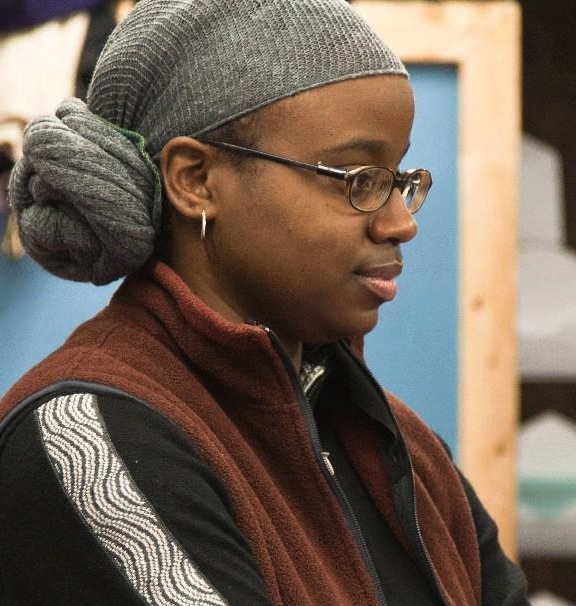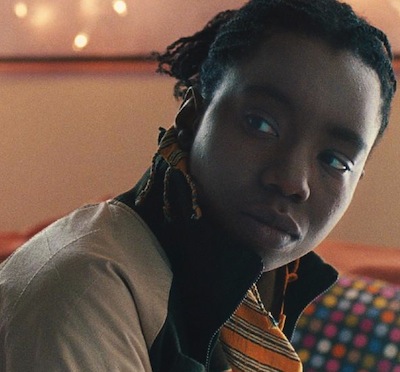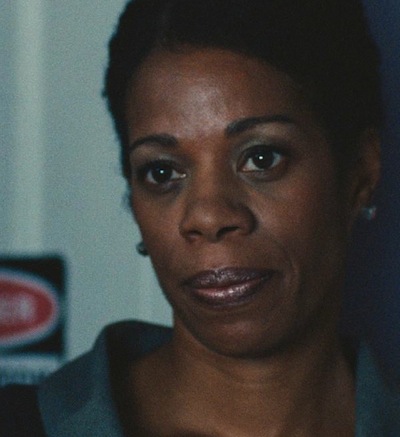 Some filmmakers debut their movie at the Sundance Film Festival, catch the eye of a few investor types and cross their fingers for even the smallest form of distribution.
Some filmmakers debut their movie at the Sundance Film Festival, catch the eye of a few investor types and cross their fingers for even the smallest form of distribution.
Dee Rees, on the other hand, came to Sundance, blew us all away with her first feature Pariah, hooked up with Focus Features and now finds herself in a whirlwind of success. The movie, an intimate portrait of a high school lesbian living, struggling and surviving in New York City, takes a familiar environment and coming-of-age-tale, and carefully and gracefully executes to electrifying results. Some of that comes from Rees’ own experiences, which she ingrained into her screenplay. Most of it is intelligent and riveting filmmaking choices—from photography to performance to editing.
I had a chance to chat with Rees on developing and directing Pariah, which is currently out in limited release:
I spoke to you back at Sundance and, since the movie debuted, so many amazing things have happened for you and the cast. What was your experience after the festival like?
Dee Rees: Some great things We’ve got a chance to connect with our audience. People are affirming that this tells their story. People are confirming that this is a universal story they are able to get to. It’s about identity. We had a chance to screen for a lot of different audiences. People from all backgrounds are able to connect to the material and love the characters, and kind of see themselves at some point in the story.
We screened in Dallas, Texas for a predominantly straight white audience and they loved the film. We screened in Boston, Massachusetts. We screened in Atlanta, Georgia. We screened in DC. So, audiences—straight, gay, black, white—everybody has really responded to the film, and has really been able to connect to Alike’s [the main character] journey.
The film was originally planned as a feature, and then you went backwards and adapted it as a short, and then you had to go forward again and readapt it into a feature. So how did the movie evolve over that time? What changed and what stayed the same?
DR: It began as a feature film. It was always conceived as a feature: one hundred and forty pages. A much bigger scope. Basically, I needed a thesis to graduate. So, I took the first act, and kind of changed some stuff around to make it stand as a short. The thing that changed is the depth of character. I was able to really understand Audrey more, understand Arthur more. That was the biggest thing that changed between the first draft and the tenth draft. The characters deepened and everybody became more well-rounded.
But it was always intended to be a feature piece. In some ways, it’s actually harder to tell a short film. Because how do you, in a limited amount of time, develop these relationships and develop these characters? It was a pleasure and a relief to get back to the thing that the film was always supposed to be.
One of the main differences between the short and the feature is the expansions of Alike’s family. Why did you decide to give them more time in her story?
DR: As a writer, I was challenged to spend time with Arthur [Charles Parnell] and Audrey [Kim Wayans] away from Alike. You know? Because nobody is the supporting character in somebody else’s life. Everybody feels like they’re the leading character in their own life. In that same way, I really had to spend time with Audrey at work. What does Audrey want? What does she feel? What is it that she’s so disappointed about? The same thing with Arthur. What is his peer pressure like? What is his circle? Alike is not the only one having peer pressure. It was basically spending time with the characters away from Alike that allowed me to get inside them more.
 One of the exercises I did, I wrote a monologue from each character’s point of view. How would Audrey tell the story from beginning to end if she’s talking to a coworker ten years from now? Same thing with Laura and Arthur. The biggest thing to help me with character development was by telling the story from each character’s point of view. And through the exercise, you come up with anecdotes that may not necessarily go inside the script, but just give you perspective on who the characters are.
One of the exercises I did, I wrote a monologue from each character’s point of view. How would Audrey tell the story from beginning to end if she’s talking to a coworker ten years from now? Same thing with Laura and Arthur. The biggest thing to help me with character development was by telling the story from each character’s point of view. And through the exercise, you come up with anecdotes that may not necessarily go inside the script, but just give you perspective on who the characters are.
I’ve heard the movie is rooted in a good amount of truth, drawn from your own experiences. What aspects of the movie did you pull from your own life and what things did you still have to research to depict truthfully?
DR: I don’t research as a writer, I just write. But there are autobiographical things. I came out at twenty-seven, and I’m from Nashville, Tennessee. From the suburbs, from Antioch. So obviously, growing up in Brooklyn in a brownstone isn’t my experience. But a few of the things that I relate to Alike with…this struggle in realizing that there’s a rendered gender identity.
When I first came out, I would go to clubs, and I realized that there’s this very binary sexuality. Either butch or fem. You’ve got to be hard, or you’ve got to be soft. In that same way, Alike struggles to just be herself. She’s being asked to check a box. Laura is pushing her to be this more butch person that she’s not. Audrey is pushing her to be this more feminine person that she’s not. She’s somewhere in between Learning that’s OK is something Alike goes through.
Also, the idea that your spirituality and your sexuality don’t have to be mutually exclusive was something that I struggled with. When I first came out, I worried that God didn’t love me anymore. Somehow, I had separated myself. I’ve realized that God still loved me and was with me. My spiritual resolve was what got me through the times where things were hard. That’s what Alike realizes. Her mother tries to use that line, “God doesn’t make mistakes,” as a weapon. And then in the end, Alike turns it around and uses it as an affirmation. She is who she’s supposed to be.
And finally, the third thing that was similar was the parental struggle. When I first came out, I was twenty-seven, not seventeen. So, I was living in New York City and paying my own bills. But still, my parents had a hard time accepting it. Having to draw a line in the sand, and having to explain that I was still the same person that I always was, and that I wasn’t being influenced, and that I wasn’t damaged in some way, and that my sexuality was not an effect and not a symptom of something. It was a long struggle. Things weren’t the greatest between us for a couple years. We weren’t really talking. Alike’s parental struggle is dramatized differently. But you have to kind of stand up to the people who brought you into the world. Those kinds of themes were autobiographical, but the world was not. And the particular teenage experience was not.
Your actress who plays Alike, Adepero Oduye, is so brilliant, so natural, in the movie. How did you convey your vision and help her discover these ideas and events that were familiar to you?
DR: I like to talk a lot. So we’d talk a lot about the character, and about the world and my experiences. I like to work in exercises, also. Rather than line readings, I had Adepero and Pernell Walker (who plays Alike’s friend Laura) go in costume to Dave and Busters Times Square, so they could feel what it’s like to be a masculine-identified woman in a straight environment. How do people look at you on the train ride over? How to people look at you in the restaurant? How do people not look at you, and kind of avoid eye contact? So they could feel what it’s like to be in these characters’ shoes. What it’s like to be a masculine-identified lesbian woman in a straight world. And I’d have them go off in costume to a lesbian club, so they could feel like what it’s like to be a masculine-identified woman in a lesbian environment.
For Pernell, she was very comfortable with that. She was dancing with three girls, getting phone numbers, taking pictures. Totally the bell of the ball. And then for Adepero who plays Alike, she wasn’t quite sitting right in her clothes and her own skin. She wasn’t comfortable, and was a total wallflower. She would not try to dance or talk to people. That was the best way to kind of thrust them into the experience, to walk in the characters shoes and…experience different worlds. Because theirs is kind of a dual consciousness that exists. They have to be able to feel that, and to bring that experience to the roles.
For the family, I had a psychotherapist come in and do a mock therapy session. Put them on the couch—they had talking points. Things they wanted to avoid, things they wanted to discuss. And I would often make those points at odd with what someone did not want to talk about. And by sitting on the couch with the family, they feel the dysfunction. They know what this family is about—versus just reading lines. Those are the kinds of exercises I like to do to get the [actors] into the roles, into the minds of the characters. For the love relationship, I got to workshop Alike and Bina. At the Sundance lab, they’re homework assignment was to ride a ski lift together. The perfect awkward first date. We’d come up with inspirational things I could do so they could create the shared history together and bring that to set.
Was Adepero the first person you found? Kind of the lynchpin? Or was there another actress?
DR: Adepero was the first one. She actually came to us while we were auditioning for the short. And she literally came in the first audition. It was like, ‘Oh my God! How did our lead walk in the first day?’ But she was really un-self-conscious. She completely vanished inside the character and was Alike one hundred percent. Who she is on screen is not who she is in person. I have to keep reminding people it’s not a documentary.
Oddly, that can be hard for some people to wrap their minds around. ‘It’s not truth.’
DR: Yeah, definitely! Exactly. She’s really acting. And she’s not seventeen, she’s thirty-three…she’s really putting on a huge performance here.
 When you brought Adepero on, since she was there from the beginning, did you cast everyone else against her? She’s kind of your companion in this process.
When you brought Adepero on, since she was there from the beginning, did you cast everyone else against her? She’s kind of your companion in this process.
DR: I did, yeah. When we were trying to find Laura, I tested a couple of actresses against her. It was important that the actresses be good on their own, but it was important that they had good chemistry with her and that I could believe that they were friends. So as we were trying to find Laura, we’d bring in actresses to read with her as Laura. Even when we were trying to find Arthur, we’d bring them in to read against her. So I definitely cast people against her, because she was the lead. She was the anchor. I wanted to put together a really great ensemble cast, and the chemistry had to be right between everybody.
A lot of people are talking about Kim Wayans in this movie,as the role is a real departure for her. But what was it about her specifically that worked for you? What does she bring to the table?
DR: What’s so special about Kim is that she brought the loneliness and the vulnerability that was Audrey’s core. We read a lot of actresses and had a tough time finding Audrey, because everybody kept playing the anger. They could give me a stereotype. They could give me the angry black mama thing. Kim was the only actress that got Audrey’s loneliness and her vulnerability. She’s the only one who really saw who Audrey was. Kim walked in the room and showed us an Audrey we’d never seen before. She was another one—on the first audition, we knew that she was the one that captured it. She brings this sensitivity and this nuance to the role that I think is amazing.
Just to wrap up here, when I was talking to you back at Sundance, you were developing a TV show called The Ville….
DR: Yep!
But you’ve been rounding up a ton of other projects since, including something with Viola Davis. What’s next for you?
DR: The Ville is an original TV series. We just sold it to a network, so we’re in negotiations now. We hope we’ll be able to turn out something in January. The [project] with Viola Davis is a TV series for HBO. And then for Focus, I wrote a feature called Bolo, set in the South. I’m excited about it. It’s also original. And then, also another original screenplay outside of that called Large Print. That’s an original spec screenplay. Two features and two TV shows later, I’m just continuing to try to create socially conscious, meaningful work that gives us insight into worlds and characters that we haven’t seen before.


